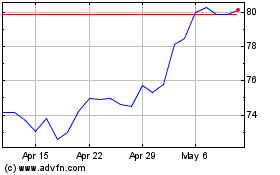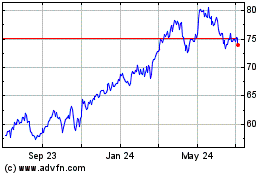By Leslie Scism and Joann S. Lublin
American International Group Inc. Chief Executive Peter Hancock,
apparently having lost the faith of the insurer's directors, quit
at a board meeting Wednesday where his future was being discussed,
according to people familiar with the matter.
The unexpected departure of Mr. Hancock, after less than three
years at the helm, came weeks after the insurer posted a $3 billion
loss for the fourth quarter that shocked investors and caught
management and the board flatfooted. The loss left Mr. Hancock in a
precarious position having just a year ago fended off pressure from
activist investors by agreeing to meet a series of financial
targets -- targets that AIG then missed.
AIG announced Mr. Hancock's resignation early Thursday morning
and said he would stay on while a successor is found. The company
hasn't yet decided whether to hire a search firm to look for a new
CEO, the people said, a sign of how quickly Mr. Hancock's fate was
decided.
The Wall Street Journal reported late last month that the board
was unhappy with Mr. Hancock's performance and was weighing his
future.
Mr. Hancock's looming departure means the insurance firm, just a
few years removed from an $185 billion government bailout, will
again have to re-establish its leadership and set a new course --
this time with activist investors and, like other insurers, deal
with the continued pressure from low interest rates.
AIG shares, which fell 9% on the Feb. 14 announcement of the
poor quarterly results and the missed targets for improved
profitability, are up 13% since Mr. Hancock took over in September
2014, below the performance of the S&P 500 and of peers. AIG's
shares slipped 0.4% Thursday.
Mr. Hancock's departure marks a win for activist investor Carl
Icahn, who had called for a new leader at AIG in late 2015, before
reaching an agreement with the insurer on the profitability
measures. A representative of Mr. Icahn joined the board at that
time.
On Thursday, Mr. Icahn tweeted, "We fully support the actions
taken today by the board of AIG."
Mr. Hancock, 58 years old, has run AIG since September 2014.
The former banker was hired by AIG in 2010 to oversee exposure
to risk, among other matters, and in 2011 was promoted to run the
global property-casualty unit, setting him up as the heir apparent
to the late Robert Benmosche, then CEO.
In a memo to employees Thursday morning, Mr. Hancock said his
decision to resign was "extremely difficult," but he believed "a
protracted period of uncertainty could undermine the progress we
have made, and damage the interests of employees, policyholders,
regulators and shareholders."
Many of AIG's woes date to its near collapse in 2008. Less than
five years later, in late 2012, AIG celebrated its
once-unimaginable payback of the money with a media campaign, and
it was widely viewed as a success story.
But the company was far from the powerhouse it had been before
the financial crisis.
Divestitures to raise dollars for the repayment roughly halved
AIG in terms of total assets, and some of its biggest profit
generators -- overseas life-insurance operations, among them --
were sold off.
Then, last month, Wall Street analysts questioned the company's
credibility after it posted an unexpectedly large fourth-quarter
claims-reserve boost of $5.6 billion. The move marked one of AIG's
worst quarterly reports since the U.S. government bailed it
out.
Rival executives have said AIG had been undercutting them on
prices in an effort to bolster business while trying to recover
from its near collapse. That led to poor decisions that ultimately
resulted in the massive increase in reserves, they said. Meanwhile,
analysts noted that the reserve boost additionally applies to
policies sold to corporate clients more recently, when Mr. Hancock
began running the property-casualty unit.
In the wake of last month's disappointing results, some analysts
had begun floating names of possible replacement candidates.
Numerous analysts have emphasized that they think the company needs
to recruit someone with deep insurance experience, which Mr.
Hancock lacked before joining AIG.
Mr. Hancock has been seeking to bring AIG's performance in line
with the best of its peers by the end of 2017, working with a
timetable he and the board announced in January 2016.
That timetable was worked up amid the calls in late 2015 by Mr.
Icahn and billionaire investor John Paulson for a breakup of the
company.
The profit-improvement pledges were key in the activists'
decision to pass on a board fight last year, and last spring Mr.
Paulson joined the board alongside Mr. Icahn's representative,
Samuel Merksamer.
Douglas M. Steenland, AIG's chairman, on Thursday said, "As CEO,
Peter developed the two-year strategic plan announced in January
2016. The Board believes strongly that this is the right plan and
remains committed to the financial targets and objectives we've
announced."
Among the most glaring of AIG's weaknesses since the crisis has
been a below-industry-average return on equity, a closely watched
financial metric reflecting profits earned against capital invested
in the business. Back in 2015 AIG's return on equity stood at
roughly 8%, below the 13% to 15% notched by some rivals, such as
Travelers Cos. and Chubb.
The version of the metric watched by analysts sank to about 5%
in the poor fourth-quarter results.
Over the past year, Mr. Hancock's team has been selling
operations and assets to streamline and better focus AIG and
cutting expenses.
AIG promised investors last year that it would return $25
billion to shareholders by this year's end, through stock-buyback
programs and dividends. Between January 2016 through early
February, it had returned $14.3 billion.
At the same time, Mr. Hancock has spent heavily to upgrade the
company's information-technology systems. Mr. Hancock's departure
will follow the exit of Philip Fasano , AIG's chief information
officer since 2014. He agreed to depart by mutual agreement to
pursue outside opportunities, according to a memo sent earlier this
week to employees.
Mr. Hancock was born in London and grew up in Hong Kong, where
his father worked at a Canadian insurer. He attended England's
Oxford University and spent most of his career in finance, rising
up the ranks at J.P. Morgan, now part of J.P. Morgan Chase &
Co., over two decades to run its global fixed-income business
before becoming the company's chief financial officer.
In hiring Mr. Hancock in 2010, AIG noted that his expertise with
financial products would help with its recovery.
David Benoit contributed to this article.
Write to Leslie Scism at leslie.scism@wsj.com and Joann S.
Lublin at joann.lublin@wsj.com
(END) Dow Jones Newswires
March 10, 2017 02:47 ET (07:47 GMT)
Copyright (c) 2017 Dow Jones & Company, Inc.
American (NYSE:AIG)
Historical Stock Chart
From Mar 2024 to Apr 2024

American (NYSE:AIG)
Historical Stock Chart
From Apr 2023 to Apr 2024
